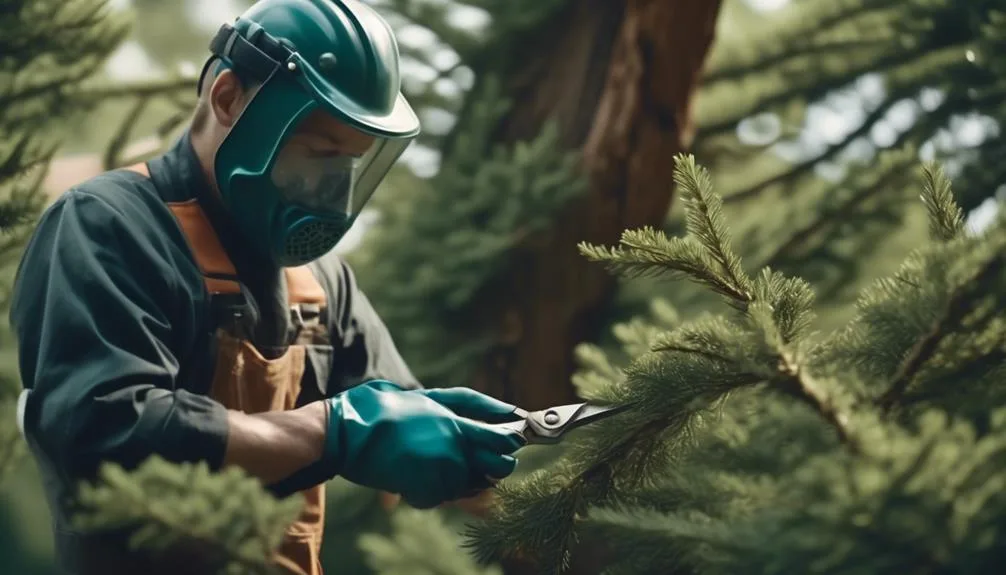Pruning cedar trees can be puzzling, but there are specific techniques to bring out their best. Understanding their unique growth patterns is key to maintaining their natural beauty. With the right approach, you can ensure that your cedar trees thrive.
But what are the essential techniques for pruning these majestic trees? Discover the key aspects to keep your cedar trees in top-notch condition and achieve optimal results.
Understanding Cedar Tree Growth Patterns
To understand cedar tree growth patterns, observe how the branches angle themselves to catch the most sunlight and how the trunk grows to support the weight of the tree.
Cedar tree pruning is crucial for maintaining a healthy and aesthetically pleasing tree. When considering pruning, it's important to understand the natural growth patterns of cedar trees.
The branch structure of cedar trees tends to be horizontally layered, allowing for efficient sunlight absorption. It's essential to preserve this structure while pruning to promote healthy growth.
Understanding how the trunk supports the weight of the tree is also vital for pruning decisions. Proper pruning not only enhances the tree's appearance but also contributes to its overall health.
Selecting the Right Pruning Tools
How do you ensure that you have the right pruning tools for effectively maintaining the health and appearance of your cedar trees? Choosing the right tools is essential for successful pruning and ensuring the safety of both the trees and the pruner. Here are some key considerations to keep in mind:
- Quality and Sharpness: Invest in high-quality pruning shears, loppers, and saws that are sharp and well-maintained to ensure clean cuts without causing unnecessary damage to the cedar trees.
- Appropriate Size and Reach: Select tools that are suitable for the size and height of your cedar trees, allowing you to reach and prune effectively without overreaching or straining yourself.
- Safety Precautions: Prioritize tools with safety features such as ergonomic handles, locking mechanisms, and protective sheaths to minimize the risk of accidents during pruning activities. Always wear appropriate safety gear, including gloves and eye protection, when using pruning tools to further ensure safety.
Timing: When to Prune Cedar Trees
Prune cedar trees during the dormant season to promote healthy growth and minimize stress on the trees. The best time for pruning is late winter or early spring before new growth begins. During this time, the cedar trees are dormant, which reduces the risk of sap loss and disease transmission. Pruning during the dormant season also helps the trees recover more quickly and minimizes the impact on their energy reserves.
Avoid pruning in the fall as it can stimulate new growth that may not harden off before winter, making the trees vulnerable to cold damage. By following these seasonal considerations, you can ensure the best practices for pruning cedar trees, maximize pruning benefits, and minimize potential risks to the trees.
Proper Techniques for Pruning Cedar Trees
When approaching the pruning of cedar trees, it's essential to employ proper techniques to ensure the health and vitality of the trees. Here are some key techniques to keep in mind:
- Pruning frequency: Cedar trees generally require minimal pruning. It's best to prune them during the late winter or early spring to minimize stress and sap loss. Regular inspections for dead or diseased branches should also be conducted throughout the year.
- Understanding branch structure: Before pruning, it's important to understand the natural growth pattern of cedar trees. Focus on removing dead, damaged, or crossing branches to improve air circulation and maintain a balanced branch structure.
- Pruning cuts: Make clean cuts just outside the branch collar to promote efficient healing and reduce the risk of disease. Avoid leaving stubs or causing unnecessary damage to the tree.
Addressing Common Cedar Tree Pruning Mistakes
As you consider pruning your cedar trees, it's crucial to be aware of common mistakes that can impact their health and appearance. Two common mistakes to avoid are over pruning and improper branch spacing. Over pruning can stress cedar trees, leaving them vulnerable to diseases and pests. It's important to only remove dead, damaged, or diseased branches and to avoid excessive trimming. Improper branch spacing can also affect the tree's health and aesthetics. When pruning, ensure that branches are evenly spaced to promote balanced growth and prevent overcrowding. Below is a table summarizing these common pruning mistakes and their impacts:
| Mistake | Impact |
|---|---|
| Over pruning | Stress, vulnerability to diseases |
| Improper spacing | Uneven growth, overcrowding |
Conclusion
Incorporate these techniques and timing considerations to maintain the health and appearance of your cedar trees.
By avoiding common pruning errors, you can ensure their long-term vitality.
With proper care, your cedar trees will continue to flourish and enhance their surroundings.
Happy pruning!

My interest in trees started when I first saw the giant sequoias in Yosemite.
I was a teenager then, and I remember thinking, “I need to learn more about this.”
That moment stuck with me.
A few years later, I went on to study forestry at Michigan Tech.
Since graduating, I’ve worked in a mix of hands-on tree care and community education.
I’ve spent over ten years helping people understand how to plant, maintain, and protect the trees in their neighborhoods.
I don’t see trees as just part of the landscape.
They are living things that make a real difference in our daily lives.
